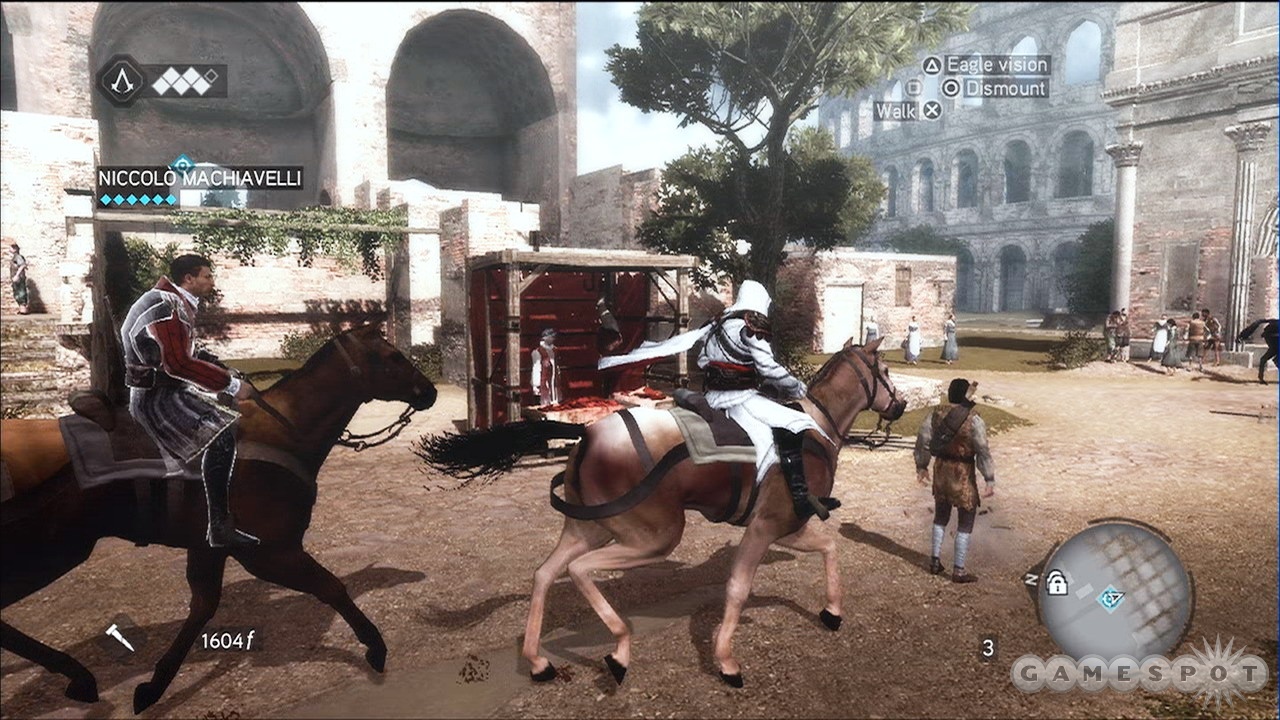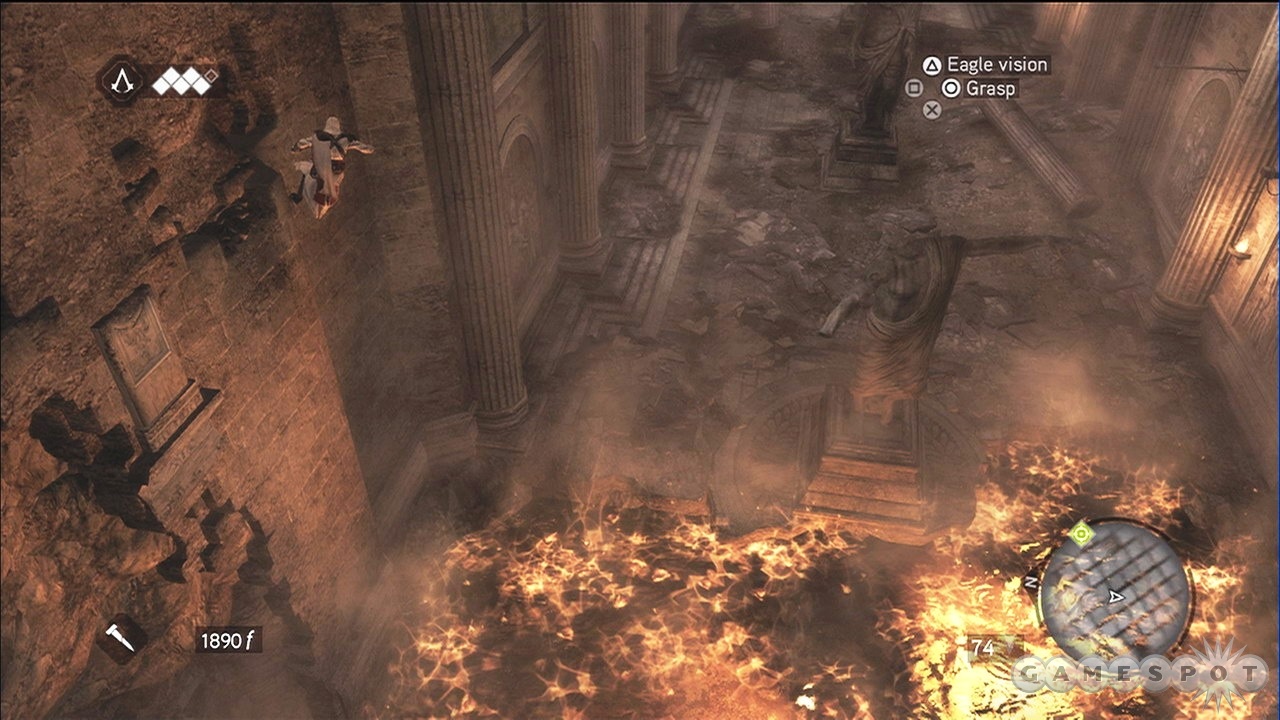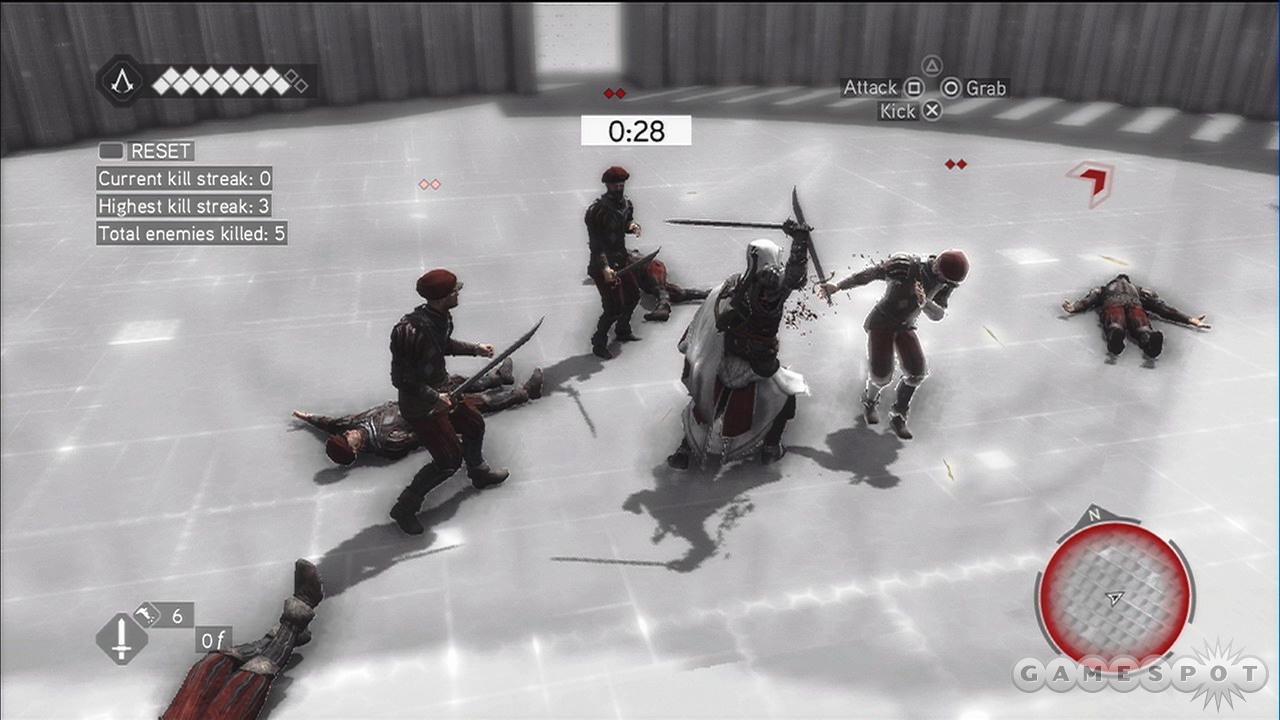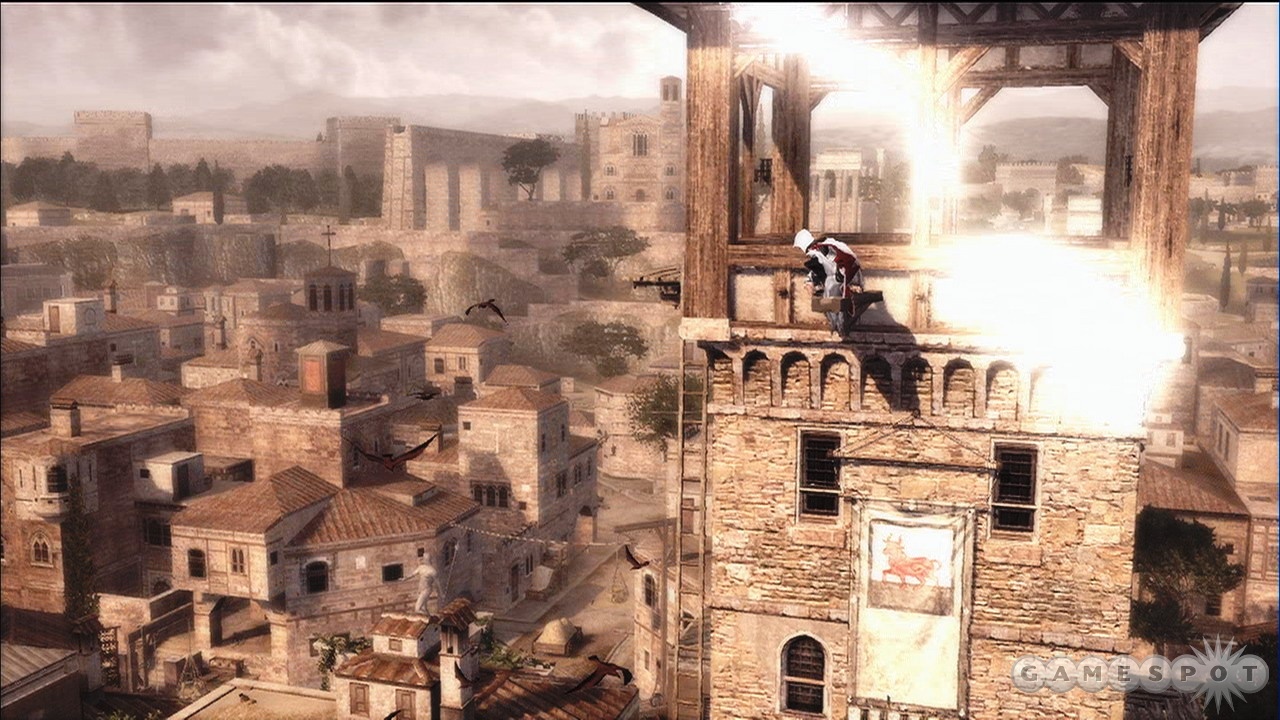The ladies of Assassin's Creed: Brotherhood have both bark and bite. If you played Assassin's Creed II, then you already know Caterina Sforza, the comely Italian countess with a soft spot for sly, rugged assassins. She's not the only female character with an important role to play in Brotherhood, however. Claudia Auditore is no longer just a submissive bookkeeper, but rather a strong young woman who eventually learns to handle a blade. And then there's Cesare Borgia's cunning sister Lucrezia, whose sharp tongue is matched by her severe, almost vampiric appearance. These willful women are ensemble players in the continuing drama of Ezio Auditore, the self-assured star of Assassin's Creed II. His story continues in Brotherhood, which begins directly after the events that closed its predecessor. This follow-up tale doesn't have the same impact of the story that spawned it, but Ezio's world is a wonder to inhabit, filled with amazing architectural detail and bursting with tons of enjoyable content.
Ezio is not the only leading man in this ongoing tale. He's an ancestor of Desmond Miles, the near-future bartender who has remained a series constant. You play Desmond in several terrific sequences, the final of which concludes with a moment so staggering it rivals Assassin's Creed II's ending for pure shock value. It's unfortunate that Ezio's part of the story isn't as memorable as Desmond's, or indeed, as memorable as his previous journey. The setup is simple: After a battle at the family's villa in Monteriggioni, Ezio's nemesis, Cesare Borgia, steals the all-important artifact known as the Apple of Eden. With the help of Caterina and other old friends, Ezio heads to Rome to retrieve the Apple and rid the city of Borgia influence. There's a bit of drama when an associate is accused of betrayal, but for the most part, Brotherhood's straightforward plot doesn't have much emotional impact, and because Ezio exhibits little personal growth, there's the slightest hint of staleness to his escapades.
That doesn't mean there aren't special story moments to savor, however. One set of side missions is a series of heartfelt flashbacks that put you in the shoes of a younger Ezio, and they let him show off that old charm that he rarely exudes in Brotherhood. Other indelible moments come by way of your glimpses of Lucrezia Borgia, who has a complicated relationship with Cesare. She knows what she wants, and she isn't afraid to test the boundaries of human decency in the pursuit of power. Lucrezia aside, few of the important players are new, but they're all voiced by a great cast that gives further gravitas to a story and world that are presented without the slightest hint of irony. Furthermore, certain story elements are given poignancy by way of their presentation. For instance, spying on a scheming Cesare and Lucrezia through a palace window makes their dialogue seem even more devious.

While Brotherhood's story falls just short of series standards, its sense of place and time is as impeccable as fans could possibly hope for. You spend the majority of the time in Rome, and while you may miss exploring multiple cities, the city is nevertheless huge and gorgeous, brimming with so much visual variety and exquisite detail that Brotherhood feels as consequential as its forebears. You might roam into a cathedral to discover a palatial view punctuated by red tapestries and golden candelabras. Citizens wandering the streets munch on apples, carry lanterns in the evening, and flirt with each other behind pillars. It is all rendered with amazing detail and lit beautifully, undercut only occasionally by visual blemishes that will be familiar to fans of the series. There is some texture fade-in, and you'll glimpse citizens popping in here and there. More notable for PlayStation 3 owners is the obvious screen tearing and less consistent frame rate. Regardless of your chosen platform, the soundtrack enhances the atmosphere with operatic soprano warbles and French horn melodies. Large portions of the soundtrack are lifted from last year's game, which is mildly disappointing; how nice would it have been to hear a new theme when synchronizing the map from atop a high perch? Regardless, the music is a graceful complement to the splendid visuals.
Within this grand world is a ton of stuff to do. The staples of the series--rooftop platforming, blending with crowds, silent assassinations, rhythmic swordplay--have all returned, and most have been enhanced or adjusted in some way. It's as joyous as ever to bound across roofs and climb to the tops of towers. Lifts that rapidly fling you to a rooftop are a great new addition and provide a second of high-speed thrills, though the movement mechanics are generally the same as before--it's the architecture and level design that have been altered for the better. As in Assassin's Creed II, you may search for glyphs hidden on walls and on rooftops, and they are perceptible only when you activate eagle vision. Finding one allows you to solve a puzzle, which in turn unlocks a small hint of a larger mystery. While most of these glyphs took only a modicum of effort to find before, they are now often hidden on sizable landmarks with tons of nooks and crannies to explore. Expect to put in more effort if you hope to uncover more of the conspiracy that drives the series. Luckily, it isn't wasted effort: ledges and outcroppings are carefully and intelligently placed, which makes it a pleasure to climb these structures.
Many towers you climb don't allow you to simply ascend with little care; they require more conscientious navigation. In fact, numerous towers not only require climbing, but must be burned to the ground as well. The Borgias have spread their influence around Rome, and to undermine their rule, you destroy their edifices. Before you can do that, you must assassinate a commander in the vicinity. Often, your target will flee if you directly engage the guards that surround him, so you will want to approach carefully. In many cases, this gives you a chance to put a new weapon, the crossbow, to good use. Not only is it handy for picking off one of these key figures, but it's also useful should a number of enemies charge you on horseback. In any case, once you have offed the key officer, you may climb to the top of the nearby tower and torch it. Afterward, you automatically take a leap of faith into a hay bale or wagon of leaves conveniently placed beneath, while melodramatic organ chords signal the importance of your endeavor.
Eliminating Borgia influence is important because you then gain access to local vendors, though this access isn't immediate. The economy, an interesting but messy feature in last year's installment, has been fleshed out in smart ways. As before, you must spend money to make money, but Brotherhood's catalog contains a lot of big-ticket items. If you want access to blacksmiths, doctors, tailors, and so on, you first must purchase and renovate their shops. Not only does renovating an empty storefront give you access to supplies, but it also begins to generate income. As you bring in money, you eventually purchase landmarks, which cost a tidy sum. In many cases this is only so you can add to your periodic bank deposits, though there are gameplay benefits as well. For example, you might be able to climb to a particular synchronization perch only after you renovate a portion of the aqueducts. Shop quests are another nice economic tweak. When you loot corpses, tackle escaping pickpockets, and empty scattered treasure chests, you may discover special items, such as prayer beads and jars of leeches. These items can be offered to designated vendors in return for high-quality weapons, tougher armor, and the like.
There's little talk of Templars in Brotherhood's campaign, but there is a new group of enemies to contend with: the followers of Romulus. Most of your contact with these beastly, fur-clad zealots is in their lairs, which take the place of Assassin's Creed II's tombs. Lairs are improvements over the tombs, however, in part because time limits are no longer so central to completing them. There is also a lot more design variety to them. In one, fires erupt beneath you, and you must leap from pillar to pillar to avoid falling into the flames. In another, you leap across great heights and use your crossbow in creative ways to cause an enormous chandelier to crash into a column. One fascinating lair is an expansive abandoned residence, which is a nice visual change of pace from the darker, more structured tomb architecture.
Many of the standard missions should be familiar to series fans: tail your target by slinking from one group of citizens to the next (it's nice that they engage in conversation with each other when you do this now, rather than remain silent); fend off a series of attackers; or navigate to specific locations so you may eavesdrop on important conversations. But even within these assignments, there is a great deal of diversity. In one case, you must infiltrate a Passion play and determine the appropriate target before he can poison your contact. In another, you must kidnap and imprison a key figure who puts up quite a fuss in the process. The missions surrounding da Vinci's inventions are perhaps the most memorable, however. They recall the flying machine mission and carriage escapes in Assassin's Creed II, but this time, you get even more impressive toys to play with and more thrilling scripted sequences. Some tasks don't quite rise to the same level. Assassin's Creed's loose movement mechanics are wonderfully suited to its free-form climbing and so-called social stealth, but are less ideal for traditional sneaking and hiding. This can lead to frustration in missions that automatically fail if you are spotted. Fortunately, these are infrequent exceptions; on the whole, Brotherhood's mission structure is inspired.
Assassin's Creed: Brotherhood's most noteworthy new feature isn't introduced until you're several hours in. In a callback to the original Assassin's Creed, distressed citizens might be under attack by Borgia's loyal soldiers. Rescuing one makes him or her loyal to your cause. From here, you control this underling's fate, sending him on various missions around the region, and even calling for his assistance in battle. These missions are handled via menus when you visit a pigeon coop. You select a contract and choose a recruit or recruits to assign, and they hopefully succeed. By completing missions, the recruits level up, and you can then improve their armor or weaponry. Eventually, they become full-fledged assassins and even celebrate their newfound status in a ceremony. Provided you haven't sent the whole cache of recruits on missions, you can call upon a few in battle, at which point they either rain down arrows from an unseen vantage point, leap out of haystacks, or charge in on horseback and engage their targets.

This aspect of Brotherhood is another way of giving you something to do in a game already full of content. At the very least, it's fun to call upon your brothers and sisters and watch them do their dirty work on your behalf. Ultimately, however, this aspect feels unnecessary and contrived. This is due in part to the combat's lack of challenge. Swordplay has been tweaked for the better, but a move that lets you string together one-slash kills keeps it from ever being so challenging that you need to call on your fellow assassins to gain a strategic advantage. More importantly, there's never any payoff for spending time improving your subordinates. The very existence of an ever-growing group of murder machines hints at an overall purpose--a grand final battle or some sort of reward for putting together the most powerful brotherhood possible. But no such reward exists, which makes the entire process feel like busywork. Granted, it's entertaining busywork, and it implies that Ezio is the full leader of a growing order. However, the feature lacks direction; it's as if you spent hours leveling up in a role-playing game, only for it to end without a climactic standoff.
You may never have thought that Assassin's Creed begged for a multiplayer component, but Brotherhood introduces one nevertheless. There are several modes, but they are all variations on the same theme: you hunt an assigned target (alone, or in a team) while simultaneously trying to avoid the player assigned to assassinate you. This isn't as easy as it sounds. You get a general indication of your target's location, and you know what your target looks like. But then again, many of the non-player characters look exactly the same; if you're smart, you'll move slowly and stay close to your look-alikes to throw your hunter off your trail while keeping your eyes open for the telltale signs of another player. To further complicate matters, you can level up and earn special powers, such as temporarily disguising yourself, or using eagle vision to spot your victim. Matches aren't packed with action, but they can be incredibly intense. You might discover your target and give chase across rooftops, only to lose the assassination contract when he escapes. Or you might leap onto your target and plunge your blade into his throat, only to give yourself away to your own pursuer. The measured tempo won't be appealing to those who thrive on ceaseless thrills, but Brotherhood's tense tug-of-war pacing makes it an appealing alternative that rewards you for careful and clever assassinations.

You may run into a few glitches here and there, such as those moments when you walk forward, only for Ezio to bend forward as if he's on a ledge, even though you are on continuously flat terrain. In addition, we fell through the world geometry and into the waters far beneath on several occasions, which required a restart. But these are uncommon occasions in a refined and sophisticated adventure. Almost every aspect of the series has seen enhancements in Assassin's Creed: Brotherhood, from travel (you can whistle for a horse and ride it almost anywhere) to value (you can now replay any completed memory). There is joy in leaping across the Roman rooftops, taking in the grand sights in front of you and realizing that it is all your own playground. Stealing a combatant's spear from him and impaling him on it is a brutal pleasure. And the little touches--the way Claudia meets Ezio's stare with one of her own, or the fluid animations that characterize your agile maneuvers--are constant reminders of what makes these games so enchanting. This may not be Assassin's Creed III, but like Ezio's smirk, Brotherhood is too irresistible to ignore.
